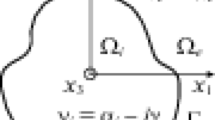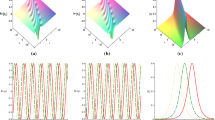Abstract
The current paper clarifies the connection between the generalized complex-frequency eigenvalue problem and the corresponding nonlinear eigenvalue problem for the set of Muller integral equations posed on two disjoint closed curves. It is proved that the last problem has no solutions if the original problem and a specially tailored eigenvalue problem do not have solutions. This result is important for using the Muller boundary integral equations in the microring lasers theory.

Similar content being viewed by others
REFERENCES
M. Abramowitz and I. Stegun, Handbook of Mathematical Functions, 2nd ed. (Dover, New York, 1972).
V. O. Byelobrov, J. Ctyroky, T. M. Benson, R. Sauleau, A. Altintas, and A. I. Nosich, ‘‘Low-threshold lasing modes of infinite periodic chain of quantum wires,’’ Opt. Lett. 35, 3634–3636 (2010).
V. O. Byelobrov, T. M. Benson, and A. I. Nosich, ‘‘Binary grating of sub-wavelength silver and quantum wires as a photonic-plasmonic lasing platform with nanoscale elements,’’ IEEE J. Sel. Top. Quantum Electron. 18, 1839–1846 (2012).
S. V. Boriskina, P. Sewell, T. M. Benson, and A. I. Nosich, ‘‘Accurate simulation of two-dimensional optical microcavities with uniquely solvable boundary integral equations and trigonometric Galerkin discretization,’’ J. Opt. Soc. Am. A 21, 393–402 (2004).
D. Colton and R. Kress, Integral Equation Methods in Scattering Theory (SIAM, Philadelphia, 2013).
W. Du, C. Li, J. Sun, H. Xu, P. Yu, A. Ren, J. Wu, and Z. Wang, ‘‘Nanolasers based on 2D materials,’’ Laser Photon. Rev., 2000271 (2020).
A. Frolov and E. Kartchevskiy, ‘‘Integral equation methods in optical waveguide theory,’’ Springer Proc. Math. Stat. 52, 119–133 (2013).
P. Heider, ‘‘Computation of scattering resonances for dielectric resonators,’’ Comput. Math. Appl. 60, 1620–1632 (2010).
E. M. Karchevskii, ‘‘The fundamental wave problem for cylindrical dielectric waveguides,’’ Differ. Equat. 36, 1109–1111 (2000).
R. Misawa, K. Niino, and N. Nishimura, ‘‘Boundary integral equations for calculating complex eigenvalues of transmission problems,’’ SIAM J. Appl. Math. 77, 770–788 (2017).
C. Muller, Foundations of the Mathematical Theory of Electromagnetic Waves (Springer, Berlin, 1969).
D. M. Natarov, T. M. Benson, and A. I. Nosich, ‘‘Electromagnetic analysis of the lasing thresholds of hybrid plasmon modes of a silver tube nanolaser with active core and active shell,’’ Beilstein J. Nanotechnol. 10, 294–304 (2019).
A. O. Oktyabrskaya, A. I. Repina, A. O. Spiridonov, E. M. Karchevskii, and A. I. Nosich, ‘‘Numerical modeling of on-threshold modes of eccentric-ring microcavity lasers using the Muller integral equations and the trigonometric Galerkin method,’’ Opt. Commun. 476, 126311 (2020).
A. O. Oktyabrskaya, A. O. Spiridonov, and E. M. Karchevskii, ‘‘Muller boundary integral equations for solving generalized complex-frequency eigenvalue problem,’’ Lobachevskii J. Math. 41, 1377–1384 (2020).
H. Reichardt, ‘‘Ausstrahlungsbedingungen für die Wellengleihung,’’ Abhandlung. Math. Sem. Univ. Hamburg 24, 41–53 (1960).
O. V. Shapoval, K. Kobayashi, and A. I. Nosich, ‘‘Electromagnetic engineering of a single-mode nanolaser on a metal plasmonic strip placed into a circular quantum wire,’’ IEEE J. Sel. Top. Quantum Electron. 23, 1501609 (2017).
E. I. Smotrova and A. I. Nosich, ‘‘Mathematical study of the two-dimensional lasing problem for the whispering-gallery modes in a circular dielectric microcavity,’’ Opt. Quantum Electron. 36, 213–221 (2004).
E. I. Smotrova, V. Tsvirkun, I. Gozhyk, C. Lafargue, C. Ulysse, M. Lebental, and A. I. Nosich, ‘‘Spectra, thresholds, and modal fields of a kite-shaped microcavity laser,’’ J. Opt. Soc. Am. B 30, 1732–1742 (2013).
A. O. Spiridonov and E. M. Karchevskii, ‘‘Projection methods for computation of spectral characteristics of weakly guiding optical waveguides,’’ in Proceedings of the International Conference on Days on Diffraction, 2013, pp. 131–135.
A. O. Spiridonov and E. M. Karchevskii, ‘‘Mathematical and numerical analysis of the spectral characteristics of dielectric microcavities with active regions,’’ in Proceedings of the International Conference on Days on Diffraction, 2016, pp. 390–395.
A. O. Spiridonov, E. M. Karchevskii, T. M. Benson, and A. I. Nosich, ‘‘Why elliptic microcavity lasers emit light on bow-tie-like modes instead of whispering-gallery-like modes,’’ Opt. Commun. 439, 112–117 (2019).
A. O. Spiridonov, E. M. Karchevskii, and A. I. Nosich, ‘‘Rigorous formulation of the lasing eigenvalue problem as a spectral problem for a fredholm operator function,’’ Lobachevskii J. Math. 39 (8), 1148–1157 (2018).
A. O. Spiridonov, E. M. Karchevskii, and A. I. Nosich, ‘‘Mathematical and numerical modeling of on-threshold modes of 2-D microcavity lasers with piercing holes,’’ Axioms 8, 1–16 (2019).
A. O. Spiridonov, A. O. Oktyabrskaya, E. M. Karchevskii, and A. I. Nosich, ‘‘Mathematical and numerical analysis of the generalized complex-frequency eigenvalue problem for two-dimensional optical microcavities,’’ SIAM J. Appl. Math. 80, 1977–1998 (2020).
Author information
Authors and Affiliations
Corresponding authors
Additional information
(Submitted by E. E. Tyrtyshnikov)
Rights and permissions
About this article
Cite this article
Repina, A.I., Oktyabrskaya, A.O. & Karchevskii, E.M. Muller Boundary Integral Equations in the Microring Lasers Theory. Lobachevskii J Math 42, 1402–1412 (2021). https://doi.org/10.1134/S199508022106024X
Received:
Revised:
Accepted:
Published:
Issue Date:
DOI: https://doi.org/10.1134/S199508022106024X




